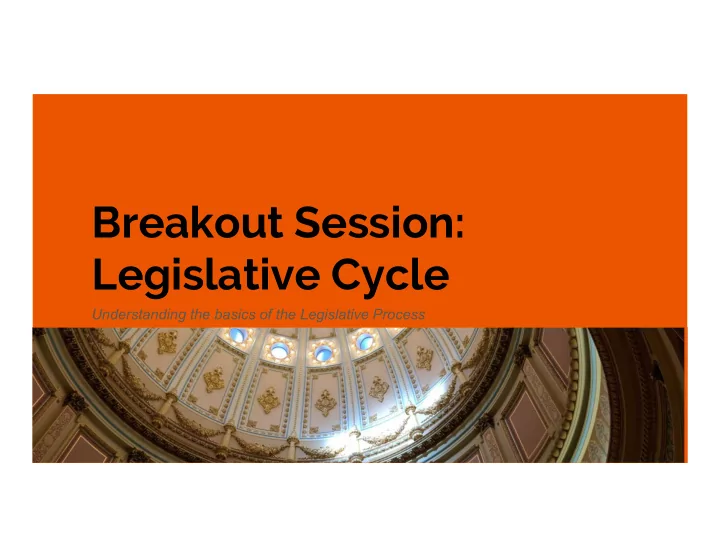

Breakout Session: Legislative Cycle Understanding the basics of the Legislative Process
Mark Neuburger mark.neuburger@jud.ca.gov Legislative Advocate 916-323-3121 Judicial Council Governmental Affairs
Outline: Legislative Office Structure ● The Legislative Process ● How the Council advocates on behalf of the branch ●
Legislative Office Structure
Have you ever wondered… ● Who come up with bill ideas? ● Who helps the legislator vote on bills and budget requests? ● How does the Council interact with these individuals?
Capitol office staff
Capitol Office staff typically: Review bill ideas that are presented by ● advocates & stakeholders Develop their own bill ideas ● Help the legislator decide what bills to ● author/carry in their legislative package. Review legislation to advise the members ● if they should vote for or against a bill or budget issue.
Committee office staff
District office staff
The takeaways: Lawmaker’s capitol office staff draft bills and ● are responsible for guiding the bills through the legislative process. Committee staff are generally responsible for ● the policy areas that the bill impacts. They work with stakeholders and the authors office to modify bills to address these concerns. District office staff are responsible for ● constituent case work and addressing issues within the legislator’s district.
Legislative Process
Legislative Process ● Legislative calendar ● Senate & Assembly features ● Advocating for the Branch
Legislative Calendar
Legislative Calendar Calendar is set annual as ● required by State Constitution ○ Legislative Joint Rules ○ Available: ● On Sen/Asm. Websites ○ Daily File ○
Legislative Calendar ● Jan-Feb: bill introductions
Legislative Calendar ● Jan-Feb: bill introductions ● Mar-May : Committee hearings
Legislative Calendar ● Jan-Feb: bill introductions ● Mar-May : Committee hearings ● End of May: House of Origin deadline
Legislative Calendar ● Jan-Feb: Bill introductions ● Mar-May : Committee hearings ● End of May: House of Origin deadline ● June-Aug: Budget & house switch
Legislative Calendar ● Jan-Feb: Bill introductions ● Mar-May : Committee hearings ● End of May: House of Origin deadline ● June-Aug: Budget & house switch ● Aug-Sept: End of session
Legislative Calendar ● Jan-Feb: Bill introductions ● Mar-May : Committee hearings ● End of May: House of Origin deadline ● June-Aug: Budget & house switch ● Aug-Sept: End of session ● Sept-Oct: Governor signs bills Image credit: Office of California Governor Gavin Newsom, 9/30/2019
Legislative Calendar ● Jan-Feb: Bill introductions ● Mar-May : Committee hearings ● End of May: House of Origin deadline ● June-Aug: Budget & house switch ● Aug-Sept: End of session ● Sept-Oct: Governor signs bills ● Sept-Dec: Legislative recess
Special notes about 2nd year of session: 2-year bills left over from the first year ● Bills die in the second year; must be reintroduced in next session ● Recess during election years ●
The Senate & Assembly
Size of each house and district SENATE ASSEMBLY 40 members 80 members 950,000 475,000 Constituents Constituents
District boundaries: then & now Senate: Prior to 1964 were divided by county; a ● court decision ( Reynolds v. Sims ) changed districts to population-based Lines: used to be drawn by legislators; now drawn ● by Citizens’ Redistricting Commission 2020 Census: Will result in new district lines ●
Terms & Term Limits SENATE ASSEMBLY 4 year term 2 year terms 3 terms total 6 terms total
Power Difference Senate Confirming powers ● Senate has the authority to confirm the Governor’s appointments ○ Performed by Senate Rules Committee. ○ Majority of Governor’s appointments are approve. ○
House and Caucus Leadership SENATE ASSEMBLY President pro Speaker of the Tempore Assembly Republican Republican (Minority) Leader (Minority) Leader
The takeaways: Bills must pass certain legislative calendar deadlines. ● All bills ‘die’ at the end of the 2 nd year ● Differences between Senate and Assembly ● Legislative leadership positions ●
Advocating for the Branch to Lawmakers and Staff
Audience Legislators and staffer concerns: Constituents ● Influential people ● Organizations ● Political concerns ●
Advocacy How will the bill impact the courts: ● Mission ● Case types ● Funding ● Countering ● Follow-up
Fiscal impact of a bill Understand impacts to workload ● and operations Use relevant data and cost model ● to develop estimate. Back up with relevant examples ● Ensure estimate is in line with ● similar bills. Defensible ●
The takeaways: Engaging with the legislature does not ● guarantee that they will appreciate the branch’s concerns on a bill. Positive interactions should lead to legislator’s ● and staff who are more aware of our issues, and helps build long-term relationships.
Thank You
Recommend
More recommend